"문경 송죽리 개성고씨 가옥"의 두 판 사이의 차이
(새 문서: {{진행중}} {{문화유산정보 |사진=문경송죽리개성고씨가옥.jpg |사진출처=[http://www.heritage.go.kr/heri/cul/culSelectDetail.do?ccbaCpno=3413705890000 문경 송...) |
(→영문) |
||
| 36번째 줄: | 36번째 줄: | ||
'''Historic House of the Gaeseong Go Clan in Songjuk-ri, Mungyeong''' | '''Historic House of the Gaeseong Go Clan in Songjuk-ri, Mungyeong''' | ||
| + | This house was built in 1933 by Go Wan (1863-1953) and his son, Go Seokrim. Among the traditional commoner’s houses in the area of Mungyeong, this house is one of the larger one. | ||
| + | |||
| + | The house consists of a gate quarters, women’s quarters, men’s quarters and a storehouse. The women’s quarters and the men’s quarters are oriented perpendicularly to each other with the women’s quarters facing the east and the men’s quarters facing the south. This layout is different from the typical one when the women’s quarters and the men’s quarters are placed next to each other or one in front of the other. Moreover, following the customs of Confucianism a traditional Korean house should have separate spaces for men and women, however in this case entering the women’s quarters requires passing through the men’s quarters thus the gender separation is not that definite. | ||
| + | |||
| + | The women’s quarters includes a wooden-floored hall at the center with two underfloor-heated rooms on either side, and a narrow wooden veranda surrounding these buildings. Tall doors without a threshold that have a small window on top used for ventilation and other elements show how traditional Korean houses of the 20th century changed due to the new lifestyle. | ||
===영문 해설 내용=== | ===영문 해설 내용=== | ||
2020년 10월 18일 (일) 13:49 판
| 문경 송죽리 개성고씨가옥 Historic House of the Gaeseong Go Clan in Songjuk-ri, Mungyeong |
|
 문경 송죽리 개성고씨 가옥, 국가문화유산포털, 문화재청. |
|
| 대표명칭 | 문경 송죽리 개성고씨가옥 |
|---|---|
| 영문명칭 | Historic House of the Gaeseong Go Clan in Songjuk-ri, Mungyeong |
| 한자 | 聞慶 松竹里 開城高氏家屋 |
| 주소 | 경상북도 문경시 덕암안길 19-6 (산양면) |
| 지정번호 | 경상북도 문화재자료 제589호 |
| 지정일 | 2011년 6월 2일 |
| 분류 | 유적건조물/주거생활/근대주거/근대도시 |
| 시대 | 일제강점기 |
| 수량/면적 | 4동 |
| 웹사이트 | 문경 송죽리 개성고씨 가옥, 국가문화유산포털, 문화재청. |
|
|
|
해설문
국문
송죽리 개성고씨 가옥은 개성고씨 치당공(痴堂公) 고완(高浣)과 그의 아들 고석림(高碩林)이 1933년 세운 살림집으로, 안채·사랑채·고방채*·대문간채로 이루어져 있다. 안채는 동쪽 방향을 향해 있는데 남쪽을 향해 있는 사랑채와 직각으로 배치되어 있다. 일반적으로 안채와 사랑채가 한 줄로, 혹은 나란히 놓인 것과 다른 모습이다.
안채는 근대로 들어서면서 실제 생활에 필요한 면적이 더 커지게 됨에 따라 집의 규모도 커지게 되었다. 그 과정에서 집의 평면이 세로와가로로 나누어지고 여러 겹으로 되었다. 머름** 없는 키 큰 창호, 방문 위쪽에 낸 작은 창, 환기를 하려고 만든 창 등은 19세기 후반 근대 시기의 집에서 주로 볼 수 있는 모습이다.
이 집은 문경에 남아 있는 민가 가운데 큰 규모에 속하며, 근대 시기의 역사와 문화의 변동을 살펴볼 수 있는 귀중한 자료이다.
- 고방채(庫房-, 광): 광이 있는 집으로, 창고 겸 하인들이 거처하는 곳으로 활용됨.
- 머름: 바람을 막거나 모양을 내기 위하여 미닫이 문지방 아래나 벽 아래 중방에 대는 널조각. 창 아래 설치된 높은 문지방.
영문
Historic House of the Gaeseong Go Clan in Songjuk-ri, Mungyeong
This house was built in 1933 by Go Wan (1863-1953) and his son, Go Seokrim. Among the traditional commoner’s houses in the area of Mungyeong, this house is one of the larger one.
The house consists of a gate quarters, women’s quarters, men’s quarters and a storehouse. The women’s quarters and the men’s quarters are oriented perpendicularly to each other with the women’s quarters facing the east and the men’s quarters facing the south. This layout is different from the typical one when the women’s quarters and the men’s quarters are placed next to each other or one in front of the other. Moreover, following the customs of Confucianism a traditional Korean house should have separate spaces for men and women, however in this case entering the women’s quarters requires passing through the men’s quarters thus the gender separation is not that definite.
The women’s quarters includes a wooden-floored hall at the center with two underfloor-heated rooms on either side, and a narrow wooden veranda surrounding these buildings. Tall doors without a threshold that have a small window on top used for ventilation and other elements show how traditional Korean houses of the 20th century changed due to the new lifestyle.
영문 해설 내용
이 집은 고완(1863-1953)과 그의 아들 고석림이 1933년에 지었다. 문경 지역에 남아 있는 전통 민가 가운데 규모가 큰 편에 속한다.
대문간채, 안채, 사랑채, 고방채로 이루어져 있다. 동쪽을 향해 있는 안채와 남쪽을 향해 있는 사랑채가 서로 직각으로 배치되어 있는데, 일반적으로 안채와 사랑채가 옆으로 혹은 앞뒤로 나란히 배치되는 것과는 다른 모습이다. 또한 전통적인 한옥에서는 유교 관습에 따라 남녀의 공간이 뚜렷이 구분되는데, 이 집에서는 사랑채를 지나야 안채를 들어설 수 있어 이러한 구분이 약해진 것을 알 수 있다.
안채는 대청을 중심으로 양옆에 온돌방을 두었고, 앞면, 뒷면, 옆면에 툇마루를 둘렀다. 문지방을 두지 않은 키 큰 방문, 방문 위쪽에 낸 작은 창, 환기용으로 만든 창 등은 생활 방식의 변화에 따라 달라진 20세기 한옥의 모습을 보여준다.
참고자료
- "문경 송죽리 개성고씨가옥", 경북북부권문화정보센터, 2011.02.28.